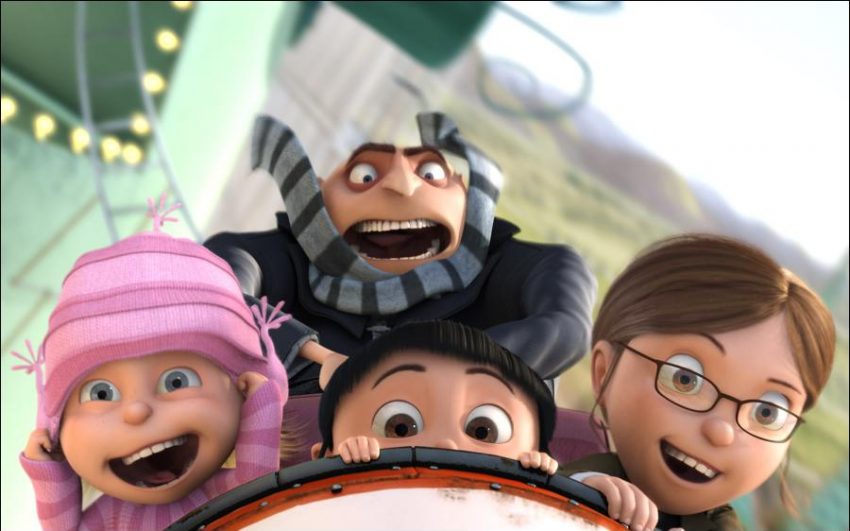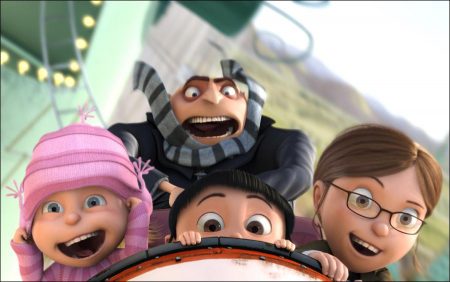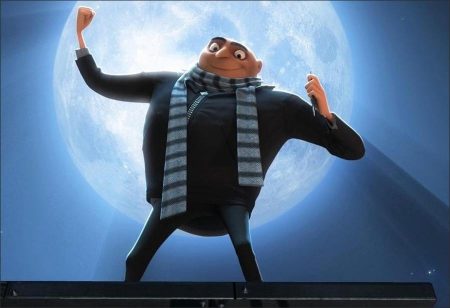Taglines: Some call him bad, “they” call him dad.
A man planning the biggest heist in the history of the world will vanquishes all who stand in his way. Gru meets his greatest challenge when he encounters three little girls. They are strong willed and look at him as a potential Dad.
In a happy suburban neighborhood surrounded by white picket fences with flowering rose bushes, sits a black house with a dead lawn. Unbeknownst to the neighbors, hidden beneath this home is a vast secret hideout. Surrounded by a small army of minions, we discover Gru (voiced by Steve Carell), planning the biggest heist in the history of the world. He is going to steal the moon (Yes, the moon!) in Universal’s new 3-D CGI feature, “Despicable Me.”
Gru delights in all things wicked. Armed with his arsenal of shrink rays, freeze rays, and battle-ready vehicles for land and air, he vanquishes all who stand in his way. Until the day he encounters the immense will of three little orphaned girls who look at him and see something that no one else has ever seen: a potential Dad. The world’s greatest villain has just met his greatest challenge: three little girls named Margo, Edith and Agnes.
In early 2007, Universal Pictures began to build its family and animation film business by bringing aboard blockbuster producer Chris Meledandri to shepherd the initiative. Meledandri had spent many years at 20th Century Fox, where he founded the studio’s animation division and oversaw the launch of its blockbuster Ice Age franchise. With the creation of Meledandri’s new production company, Illumination Entertainment, Universal would finance and distribute a slate of live-action and animated films that would be led by the successful filmmaker.
In early 2007, Universal Pictures began to build its family and animation film business by bringing aboard blockbuster producer Chris Meledandri to shepherd the initiative. Meledandri had spent many years at 20th Century Fox, where he founded the studio’s animation division and oversaw the launch of its blockbuster Ice Age franchise. With the creation of Meledandri’s new production company, Illumination Entertainment, Universal would finance and distribute a slate of live-action and animated films that would be led by the successful filmmaker.
Meledandri, who had been an executive at Fox for 13 years, became founding president of 20th Century Fox Animation during his tenure at the studio. He headed that division for eight years, amassing more than $2 billion in global box-office revenue for the studio. The producer oversaw Fox’s 1998 acquisition of the East Coast-based, small visual-effects house Blue Sky Studios and its transformation into the studio’s successful CGanimation arm, which employs more than 250 artists.
While there, Meledandri also supervised and/or executive produced such blockbusters as Robots, Alvin and the Chipmunks, The Simpsons Movie and Dr. Seuss’ Horton Hears a Who! Offers Meledandri about the transition: “I found that I could not turn away from the extraordinary opportunity that Universal offered me: the entrepreneurial aspect, the excitement about a new company, the breadth of the production mandate to include all forms of animation, as well as live action, and the studio’s ideas about movies— specifically their commitment to quality, as well as their ideas about how to market movies in an increasingly competitive marketplace.”
“The original concept of Despicable Mewas pitched to me by Sergio Pablos, who is a Spanish animator based with a small animation studio in Spain,” explains Chris Meledandri. “We immediately knew that screenwriters Cinco Paul and Ken Daurio were the team to write the screenplay.” The writers had worked with the producer on the global hit Dr. Seuss’ Horton Hears a Who!, and Meledandri felt they had just the sensibility to bring Sergio Pablos’ original story to life.
Paul and Daurio had navigated intricate animated worlds before with Meledandri. In their last film together, they gave life to Dr. Seuss’ beloved character Horton, telling the story of a gentle elephant who hears a faint cry for help from a dust mote that’s floated past. The film, directed by Jimmy Hayward and Steve Martino, was an enormous hit and solidified the two as comedy scribes. For their newest project, they elaborated upon Pablos’ idea of one of the world’s greatest super-villains, a man who finds more to life than reveling in wicked deeds.
From the beginning, it was important to Illumination to construct a tale that would put a trademark stamp on the types of films the production house would be creating. That would not involve two-dimensional heroes or antagonists. Reflects Meledandri: “The idea of making an animated film in which the villain is your protagonist is unusual and very challenging. By the end of the film, Gru has undergone a transformation, and it’s that transformation that’s made possible by starting him in a place where there are aspects of him that are downright unlikable. You would not have a sense of appreciation for the journey he’s gone on as a character had we not started him at that point.”
Fellow producer John Cohen knew that Despicable Me would stand out by showing the side of our humanity of which we’re not always so proud. “For a while, we’ve wanted to make a movie about a villain told from the villain’s perspective,” he says. “Chris heard this idea that came from Sergio Pablos, who is a terrific animator. Sergio and Nina Rowan, who are executive producers, brought this original idea to Chris.”
Good vs. Evil
While it’s initially a bit uncertain who is naughty and who is nice in Despicable Me, all will be revealed as the story unfolds. Below is a guide to the dastardly and delightful players in Gru’s world: Gru (Steve Carell) is a villain who finds great pleasure in doing deliciously wicked things to other people. Whether it’s freezing a long queue of customers ahead of him at a coffee shop or creating a balloon animal for a small boy just to pop it, Gru gets to do all of the things we only wish we could. He’s on track to become the greatest villain of all time by committing the crime of the century, but Gru’s about to face his toughest challenge yet: Fatherhood.
Gru’s nemesis, the nerdy Vector (Jason Segel), is way too geeky to be this cocky. Holed up in his sleek house/fortress, Vector can usually be found in his orange warmup suit, playing video games while plotting his next move. His favorite weapon is a gun that fires live piranhas. Unfortunately for him, Vector has a hard time keeping the carnivores inside the gun’s barrel…
The eldest of the three orphans, Margo (Miranda Cosgrove) is naturally protective of her two sisters. Raised without a family, she distrusts most people and knows the only ones the girls can count on are one another. A tough cookie and a strong protector, Margo is not afraid to challenge Gru as he tries to parent the girls. He has finally met his match.
The kid who tests all limits, Edith (newcomer DANA GAIER) might just be the last girl in the orphanage you would run to adopt. Wearing a hat pulled down over her eyes and eager to test out Gru’s dangerous weaponry, she is seen as a bit of a scoundrel. Though this middle child needs (and wants) limits, she’ll never let you know it.
An innocent little girl who loves unconditionally and wants desperately to be loved, the youngest of the three orphans lives to hug. Agnes (scene-stealing newcomer ELSIE FISHER) is obsessed with unicorns and says random, sweet things. She longs for nothing more than parents to make her family complete…and that unicorn wouldn’t hurt.
Gru’s Mom (Julie Andrews): Behind every great villain is a disapproving mom. Nothing Gru has done has been good enough for his judgmental grump of a mother. While she believes she’s quite smart in her parenting approach, the 80-year-old still treats Gru like he’s eight years old. Her overly critical attitude has inspired him toward ever-increasing feats of villainy in order to impress his harrumphing mom.
Gru’s resident mad scientist, Dr. Nefario (Russell Brand) looks to be approximately 150 years old and vacillates between flashes of brilliance and black holes of spaciness. Always hard at work building his boss the latest in incredible vehicles and weaponry, Nefario is (sometimes) sharp as a tack. His hearing, however? That began to fade at least 50 years ago. Small, mischievous yellow creatures, the minions
(Pierre Coffin, Chris Renaud and JEMAINE CLEMENT) form Gru’s not-so- bright pit crew. Hardworking and devoted to their leader and his mad exploits, the minions are content to serve as his crash test dummies. When they meet Gru’s adopted children, however, they find three little girls who are just as much fun as they are.
Miss Hattie (Kristen Wiig) runs the local orphanage where Margo, Edith and Agnes live before they are sent to live with Gru. A seemingly kind and concerned caretaker, Miss Hattie is actually a stern Southern belle who believes in tough love and big business. If you’re not making your quota by selling cookies, you’re headed for Miss Hattie’s “Box of Shame.”
Casting Comic Talent
When bringing together the cast for Illumination’s first animated feature, the directors and producers of Despicable Me were adamant about selecting actors who could not only bring out the humor of their voices, but also channel their comic physicality to inspire the many animators who worked on the project. Cohen explains: “The way we approached the casting is that we wanted to find the absolute best improvisational comedians out there. They brought a level of spontaneity and naturalistic performances to the film.”
To choose the comedy’s primary super-villain, a character who is at his wit’s end trying to become the best in his profession, the team members had to look no further than a former collaborator. Performer Steve Carell is known to millions of fans through his roles on television’s The Office and popular films including The 40-Year-Old Virgin, Get Smart and Date Night, but it was his voice that most interested the filmmakers. He first worked with Meledandri on Horton Hears a Who!, in which he vocalized the role of the Mayor of Who-ville.
“Steve has great pathos in his voice, but his voice also carries his comedy effectively,” says Meledandri. “Working with him is unique because he comes to the process as an actor, an improviser and a writer. It’s rare that Steve will not give you a version of the scene that everybody agrees has just taken that comic or dramatic sequence and made it significantly better. The process of working with him is one of discovery. You never quite know where he’s going, and yet he always takes you to a place that’s a more elevated level than where you started.”
When the team sat down with Carell to discuss his ideas about a vocal approach to Gru, Carell made the observation that great villains in movies have very memorable voices, and he didn’t want the audience to pinpoint the accent. Explains Meledandri: “Carell started to play with different vocals that involved accents, and he came up with one that lands somewhere between Ricardo Montalban and Bela Lugosi. As soon as he started playing with that voice, it began to inform our visual conception of the character.”
It wasn’t only the opportunity to play a villain that attracted Carell to the project. “The story is really sweet,” he offers. “That’s what drew me to it. As crazy as Gru sounds and as diabolical and mean and awful as he is, there is humanity to him. It comes out in little bits, all the way through. It says a lot about how people can change, and how aspects of a person can come to the surface, given a different circumstance. People aren’t either good or evil…there’s always some good to evil and there’s always some evil within good. When you see someone who on the surface just seems despicable, and then they’re not, that’s interesting and fun to explore.”
Carell also appreciated how Gru was in competition with Vector to win the title of World’s Best Villain. “It’s very frustrating for Gru to be the second-best villain in the world, because he’s a perfectionist,” the actor adds. “He’s somebody who takes pride in his work, and he wants to be the best at being bad. But there’s someone out there who is upstaging him…and he doesn’t like it a bit.”
To play Gru’s archnemesis, Vector, the team chose comedy actor/writer Jason Segel. A formidable opponent to Gru, Vector is described by Carell as “younger and with a lot of technology at his disposal. He really gets under Gru’s skin. When you’re competing for stealing the moon, you can’t really be friends.”
A newcomer to the world of animation, Segel was excited for his first time out. He also had a chance to tap into his geeky side when he came up with the voice for Vector. “I’d never done anything like this,” says Segel.
Visual Style of the Animated Comedy
When the filmmakers were determining what the world they had imagined would look like on film, they instinctively knew that Gru should never plot his villainy in a boring, humdrum neighborhood. Explains Cohen: “The look of Despicable Me and the world of the movie is very much inspired by a Charles Addams and Edward Gorey sensibility. The art director of the movie, Eric Guillon, and the production designer, Yarrow Cheney, have come up with a bright and vibrant visual aesthetic that’s unlike any other animated movie you’ve ever seen.”
Meledandri elaborates on the film’s distinctive design elements: “The characters are largely carica tures of human characters. They’ve been designed by one of the great CG character designers, CARTER GOODRICH, who among many other films designed the characters for Ratatouille. There is sophistication to the design language of this film that at first glance might skew a little bit older. The environments are designed by Eric Guillon, who is such a great talent.”
Producer Healy, who has worked with designer Goodrich before, admits: “I love how complex, humorous and interesting Carter’s character designs are. He captures so much about humanity in each of his drawings; he is just prolific. What I love about the characters he designed is that there is a huge range of types, but the people all inhabit the same world. Carter’s work demonstrates the diversity in our world, and he always gives us a unique twist of personality. His people have appeal, and I want to know more about them. That’s always a good start for building a character performance.”
Reflecting upon the art director, she adds: “Eric has a sense of fun and humor in all of his designs. His color palette is sophisticated and not overly flashy, allowing the shapes and whimsy to be at the forefront. He can draw in many styles, and all of them have a freshness and a unique appeal. Eric strongly contrasts shapes in his compositions, and the variety of the linework provides a dynamic movement and interest that is apparent at first glance. But it’s his imaginative view of the world that sets him apart. He made a cohesive world for Despicable Me, and I never tire of exploring all the incredible pieces of imagery because they are fun, comedic, inventive and totally his own.”
To find inspiration for the film, the team looked to one of its first drawings. Offers Renaud: “One of the first things Eric designed was Gru’s car, which remains identical to the way he originally drew it. We looked at that car and said, ‘Wow, I’ve never seen a car like that before!’ The world grew out of that in a weird way. That was the image we first started referring to: ‘This is our world. This is Gru’s car.’”
When they imagined how Gru would move, directors Renaud and Coffin were inspired by physical comedians from Peter Sellers to Rowan Atkinson. The super-villain is a towering presence with hunched shoulders and a hooked nose. But when he needs to do so, Gru can move with the grace of a cat. Tonally, the filmmakers created a “Spy vs. Spy” world in which Gru would be subject to all sorts of explosions and attacks—from rocket launchers to domestic sharks—and live to fight again.
It was clear to all involved that they had no interest in creating a universe for Gru and his extended family and foes that had a photorealistic quality to it. They wanted the film to have a unique color palette and a distinct stylization. But the details within the world would need to be quite striking in their hyperrealism—an incredulous fantasyland for a super-villain that was populated with very true-tolife details.
Despicable Me (2010)
Directed by: Thor Freudenthal
Starring: Steve Carell, Jason Segel, Russell Brand, Kristen Wiig, Julie Andrews, Will Arnett, Danny R. McBride, Jemaine Clement, Miranda Cosgrove, Jack McBrayer, Mindy Kaling
Screenplay by: Jackie Filgo
Production Design by: Yarrow Cheney
Film Editing by: Gregory Perler, Pam Ziegenhagen
Art Direction by: Eric Guillon
Music by: Heitor Pereira, Pharrell Williams
MPAA Rating: PG for rude humor and mild action.
Distributed by: Universal Pictures
Release Date: July 9, 2010




